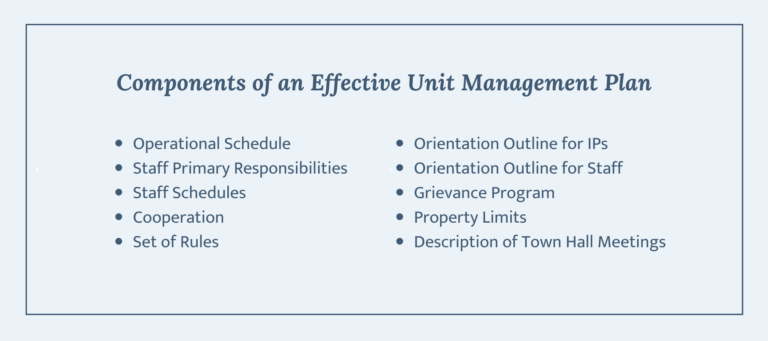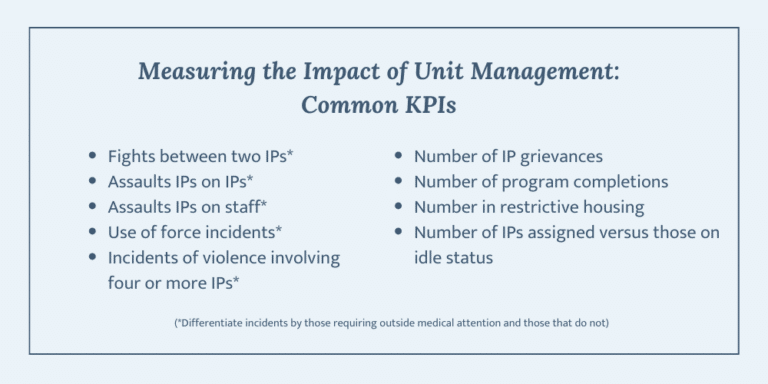
Unit Management Pt. 2: Strategies for Successful Implementation
Welcome back to our series on Unit Management. In part one, we talked about the history of Unit Management and discussed the guiding principles behind successfully implementing the concept in your facility. In this post, we dive deeper into the concept of Unit Management, defining the key components of an effective Unit Management Plan, the important role of training and establishing KPIs, and discussing a few examples of Unit Management in action in facilities across the country.
It All Starts with a Plan
In Unit Management, each unit is managed through the administrative support of the warden by the warden’s approval of a unit plan for each unit. One of the initial assignments of unit managers following their appointment is the writing of a unit plan.
Components of an Effective Unit Management Plan Include:
- An operational schedule for the unit that is compatible with the facility master schedule, to include: counts, work calls, nurses and doctors sick calls, commissary, recreation, programs (both outside and inside the unit), visiting, etc.
- Staff primary responsibilities for the unit manager, case managers, correctional supervisors, correction officers, and other staff assigned to the unit, such as a mental health practitioner, and with the expectation of staff supporting each other.
- Staff schedules that reflect a presence of the unit manager, case managers and correctional supervisors collectively seven-days-a-week and to include evening hours. The weekend and evening hours are shared by unit team members. Should an agency determine Unit Management is a desired operational approach, there are examples of staff schedules available to consult.
- Cooperation between the units and non-unit departments is articulated to ensure that the unit team members have the ability to resolve unresolved matters before they become incidents with all facility departments.
- A set of unit rules consistent with the facility and agency rules.
- An orientation outline for Incarcerated Persons (IPs), assigned to the unit.
- An orientation outline for the staff assigned to the unit.
- A listing of programs available to the IPs.
- An outline of a grievance program consistent with the facility and agency policy but emphasizing the importance of resolving grievances inside the unit with unit staff.
- Property limits
- A description of Townhall meetings between the unit team and the IPs in the unit and their frequency, which is typically monthly.
The Importance of Training
A comprehensive staff training program is essential. Unit Management is a distinctively different facility operational approach and requires a distinctive and interactive training approach for staff assigned to the unit team. This training is typically one-week in length focusing on duties and responsibilities that promotes the principle of cross-training. The unit plan provides the primary curriculum for training for all the staff assigned to the unit. Should an agency determine Unit Management is a desired operational approach for its facilities, there are examples of training outlines available for this purpose. Further, all facility staff attend a one-day training to ensure all staff recognize the responsibilities and authority of the unit team to promote responsiveness.
Establishing KPIs
As a facility considers implementing Unit Management, it is important that key performance indicators (KPIs) are identified to measure the impact of Unit Management compared to current operations. The current data will need to be collected by housing units so it can be compared to the determined unit configuration to measure the impact of Unit Management. While the indicators should be those determined to be important to the specific agency, some common metrics include:
- Fights between two IPs*
- Assaults IPs on IPs*
- Assaults IPs on staff*
- Use of force incidents*
- Incidents of violence involving four or more IPs*
- Number of IP grievances
- Number of program completions (e.g. GED, Vocational programs, substance-use programs, cognitive-based programs, etc.)
- Number in restrictive housing
- Number of IPs assigned versus those on idle status
(*Differentiate incidents by those requiring outside medical attention and those that do not)
Facilities can establish graphic depictions, such as charts or graphs, of the above performance by units that can be visible in staff areas to allow for easy tracking. Monthly recognitions for improvement in the above areas can also stimulate greater effort by the unit teams to improve results. Unit Management is designed to improve performance in all of these areas and more, resulting in safer, more productive facilities.
Unit Management in Action
It is helpful to identify some tangible examples of Unit Management and how this facility management approach is impactful in contributing to safe and productive operations.
- Red Wing operates with Unit Management principles as its foundation. It is recognized that this facility is for a juvenile population and is significantly smaller than most of Minnesota’s adult facilities. This facility operates consistently with the vision I understand from the Commissioner to be the desired state for the correctional system. Each unit is managed by a unit manager which happens to be at a lieutenant level. That unit manager directs all staff assigned to the unit and is responsible for ensuring productive programs and activities exist for the unit. Case managers are assigned to the unit and have on their caseload youth living in their assigned unit.
During the tour, there was no sign of idleness and the interaction between staff and the youth was very positive. Unit staff had a very interactive relationship with non-unit departments. The environment of the entire facility was very positive with staff exuding a sense of pride regardless of their position. There are adult IPs assigned to Red Wing to provide work details for the facility. During a focus group with just these adult IPs, it was remarkable to listen to how differently Red Wing operates compared to the other facilities. The interaction with staff is very normalized – the adult IPs discussed their ability to walk into a sergeant’s office and get their issues resolved without having to use the grievance procedure – and the staffing levels were substantially better than other Minnesota facilities, just to a name a few differences. In my 50 years in this profession – having had the opportunity to serve as a superintendent of a juvenile facility and to oversee all juvenile facilities in Ohio – during our site visit to Red Wing, I witnessed one of the finest facility cultures I have experienced in a juvenile setting. I believe this provides a tangible example of what is possible and is aligned with the Commissioner’s desired state.
- Huntingdon Correctional Facility in Pennsylvania provides an example of how Unit Management can create a positive and productive environment for staff and IPs in a facility that is 150-years-old. The facility has a population of over 1,700 Level Four (maximum security) males in old style two- and three-tiered cell blocks. It is a remarkable maximum-security facility that operates with an underpinning of the guiding principles of Unit Management. The units, despite not being uniformly designed and built in the same era, are led by a unit manager that directs all staff assigned to the unit. All staff are housed inside the unit and the unit staff closely monitor the case plans of the IPs.
The unit team initiates a recommendation for each IP at the time of their release hearing that is provided to the warden, who has a vote at the parole hearing. Each staff has a mental health practitioner (master’s level) assigned to each unit whose office is in a cell in the unit and works administratively for the unit manager while working under the license for a psychologist. When we toured, there was very little idleness in the units. IPs in the units paid little attention to us and most were out in the unit and not confined to their cells. A majority of IPs were outside the units in programs or in the recreation yard. The visit was on the 23rd of the month and an independent check of incidents found they had experienced a total number of six incidents, all one-on-one fights with no injuries resulting in outside medical attention (this was a high number for the facility and was attributed to the Eagles having been in the Super Bowl). Huntingdon is a great example of positive leadership and Unit Management principles. A site visit could be instrumental in formulating a vision for the future.
- The impact Unit Management had on the operations of Ohio’s correctional facilities was also remarkable. It was most noticeable with the implementation at the Ohio State Reformatory, the location of the filming of Shawshank Redemption, and at the time of implementation (1986), the largest steel cell block in the world. Violence was significantly reduced and program participation grew.
Next Steps to Pursue
Converting from a conventional hierarchical structure to a decentralized and accountable system supported by Unit Management is a significant undertaking. That transitional process should be supported by an agency steering committee led by an inspired leader with a point person at each site. The agency should be guided by supporting documents, including examples of unit plans, schedules, and training curriculum, and supported by experienced guidance like the direction provided by Roy B. Gerard in the ‘80s in Ohio.
For agencies who may feel intimidated at the thought of instituting Unit Management for their facility, there are operational experts and consultants who can help. I write this with the hope that my words will give them a great place to start the conversation.
This is Part 2 of our series on Unit Management. Make sure to read Part 1: The Guiding Principles of Unit Management.








